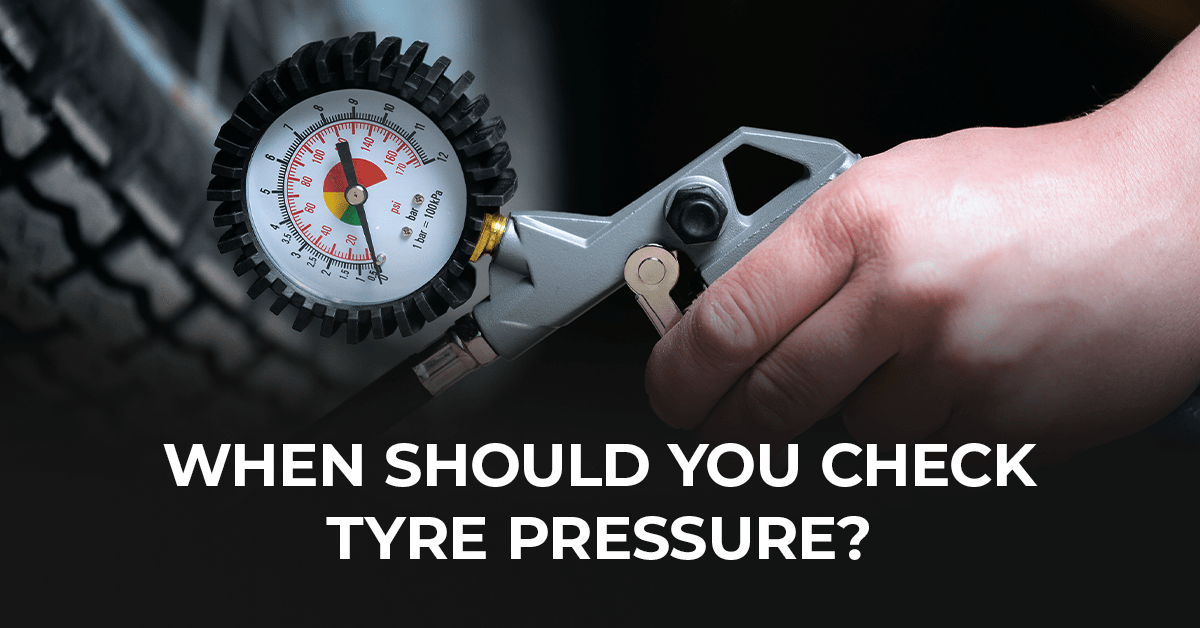Your car’s tyres will naturally lose some air each month, which is why you need to check tyre pressure regularly.
You can improve your car’s fuel economy by driving with the right tyre pressure – and ensure your vehicle is safe to drive!
Read on and find out when and how to check tyre pressure and why this is so important.
Page Contents
- When Should Tyre Pressure Be Checked?
- How to Check Tyre Pressure
- How to Use a Tyre Pressure Machine at a Petrol Station (UK)
- What Should My Tyre Pressure Be?
- How Often Should You Check Tyre Pressure?
- Why Is Correct Tyre Pressure Important?
- How Do Tyre Pressure Sensors Work?
- When Would You Increase Tyre Pressure?
- FAQs
When Should Tyre Pressure Be Checked?
Tyre pressure should always be checked when the tyres are cold, as warm tyres can give inaccurate pressure readings.
For your tyres to be classed as cold, the car should not have been driven for at least 3 to 4 hours.
If you were to set your pressures when the tyres are warm, the pressure will likely be too low.
How to Check Tyre Pressure
To check your car’s tyre pressure, you should do the following:
- Make sure the car is parked safely
- Make sure the engine is off
- Make sure the handbrake is engaged
- Note your car’s correct tyre pressure
- Use a quality tyre pressure gauge
- Remove tyre valve dust cap
- Place pressure gauge over tyre valve stem
- Press gauge down evenly on valve stem
- Check pressure gauge reading
You can find the correct tyre pressure for your car in the owner’s manual for your vehicle, or on a sticker inside the driver’s door frame (which will be identified in PSI and BAR).
If you check the reading on the pressure gauge and see that you need to inflate your tyres, use a suitable pump and add small amounts of air gradually.
If the reading shows your tyres need deflating, use the tip of a flat-head screwdriver to push on the metal pin on the valve stem – this will release some air.
Remember to take regular measurements with the pressure gauge between inflating and deflating.
Don’t forget to check your car’s spare tyre too, if you have one.
How to Use a Tyre Pressure Machine at a Petrol Station (UK)
You can use a tyre inflation pump at a UK petrol station to check your tyre pressure.
Simply insert the inflator’s nozzle into the valve on your tyre, so that the manometer (tyre inflation gauge) can display the internal pressure in PSI or bars.
You will probably hear a hiss as air escapes from the tyre, but this shouldn't affect your tyre pressure much.
You can compare the pressure displayed on the gauge with the vehicle recommended pressure for your vehicle in your vehicle owner’s manual.
If it is above the recommended pressure, you will need to release air to reach the right level.
If it is lower, then inflate the tyres to the recommended level.
Please note that if you use a tyre inflator at a petrol station the gauge will not always be reliable.
For this reason, you should have your tyre pressure checked by a professional mechanic from time to time.
Alternatively, you can buy a portable tyre inflation compressor at certain supermarkets which can plug into the power socket or cigarette lighter socket to ensure the correct tyre pressure.
What Should My Tyre Pressure Be?
You can find the recommended tyre pressure for your car in your vehicle handbook, printed inside the fuel tank flap or in the sill of the driver’s door.
You will see two types of pressure indicated – normalised pressure (which is standard pressure) and loaded pressure (for when the vehicle is particularly loaded).
Please note that the recommended pressure for your front and rear tyres may be different.
How Often Should You Check Tyre Pressure?
You should check your car’s tyre pressure once a month – and always before long drives.
Why Is Correct Tyre Pressure Important?
Incorrect tyre pressure can lead to reduced vehicle performance, which is why it’s important that you maintain the right tyre pressure for your car.
Driving on under-inflated tyres can cause the tyre structure to deteriorate, increasing the chances of a tyre blowout.
If you continue driving on under-inflated tyres, then your car could be at increased risk of aquaplaning.
Even a small difference in tyre pressure can increase the braking distance significantly.
Not to mention that under-inflated tyres will also have increased rolling distance, leading to an increase in fuel consumption.
Over-inflated tyres, on the other hand, can cause uneven tyre wear which effects handling.
Your tyres will lose traction and be harder to control.
Tyre pressure is not a specific part of the MOT test.
However, your examiner might check to see if the tyres are inflated properly and have sufficient tread depth - so you should definitely check tyre pressure before an MOT test.
How Do Tyre Pressure Sensors Work?
Tyre pressure sensors are fitted to modern vehicles to monitor and report on any tyre pressure imbalances.
The tyre pressure monitoring system (TPMS) has a sensor that triggers a warning light when there is a drop in pressure.
TPMS can tell you if your tyre is often leaking air – you can reduce the likelihood of an accident by having any issues fixed right away.
When Would You Increase Tyre Pressure?
You should check and possibly inflate your tyres before going on a journey with additional passengers or loads.
This extra pressure is required to counter the weight of the extra load.
Your tyres should only be inflated to the maximum PSI when the car is full – in other words, when there is someone in every seat and the boot is full.
You should refer to your vehicle’s handbook for guidance and reduce the pressure back to normal levels once you’ve offset the extra weight.
Maintaining the right tyre pressure is crucial for your safety and the lifespan of your car's tyres.
Make tyre pressure checks a regular part of your car maintenance routine from now on.
FAQs








No comments yet
Leave a comment